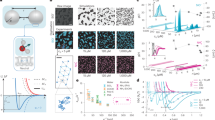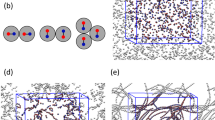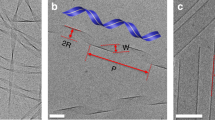Abstract
One of the most striking signatures of self-organization is spontaneous pattern formation1,2. Among the morphologies observed, stripes are intrinsically fascinating and have potential for technological applications including nanolithography and nanoelectricity. Examples of materials featuring stripe patterns include Langmuir monolayers3, magnetic films4, lipid monolayers5, liquid crystals6 and polymer films7. Stripe formation is generally attributed to the competition between short-range attractive forces and long-range repulsion arising from dipole interactions8,9. Here we show that stripe phases may result from a different mechanism based on a purely repulsive isotropic short-range pair potential with two characteristic length scales. We consider a two-dimensional (2D) assembly of particles consisting of a hard core surrounded by a soft corona and find that at densities where the hard-and-soft core radii compete with each other, decreasing the temperature induces a transition from a disordered state to an orientationally ordered phase characterized by stripe patterns.
This is a preview of subscription content, access via your institution
Access options
Subscribe to this journal
Receive 12 print issues and online access
$259.00 per year
only $21.58 per issue
Buy this article
- Purchase on Springer Link
- Instant access to full article PDF
Prices may be subject to local taxes which are calculated during checkout





Similar content being viewed by others
References
Ball, P. The Self-Made Tapestry: Pattern Formation in Nature (Oxford Univ. Press, 2001).
Bowman, C. & Newell, A.C. Natural patterns and wavelets. Rev. Mod. Phys. 70, 289–301 (1998).
Mohwald, H. Direct characterization of monolayers in the air water interface. Thin Solid Films 159, 1–15 (1988).
Seul, M. & Wolfe, R. Evolution of disorder in magnetic stripe domains. I. Transverse instabilities and disclination unbinding in lamellar patterns. Phys. Rev. A 46, 7519–7533 (1992).
Keller, S.L. & McConnell, H.M. Stripe phases in lipid monolayers near a miscibility critical point. Phys. Rev. Lett. 82, 1602–1605 (1999).
Maclennan, J. & Seul, M. Novel stripe textures in nonchiral liquid-crystal films. Phys. Rev. Lett. 69, 2082–2085 (1992).
Harrison, C. et al. Mechanisms of ordering in stripe patterns. Science 290, 1558–1560 (2000).
Seul, M. & Andelman, D. Domain shapes and patterns: the phenomenology of modulated phases. Science 267, 476–483 (1995).
Stoycheva, A.D. & Singer, S.J. Stripe melting in a two-dimensional system with competing interactions. Phys. Rev. Lett. 84, 4657–4660 (2000).
Landau, L.D. & Lifshitz, E.M. Landau Collected Papers (no.18) (ed. Ter Haar, D.) (Gordon and Breach, New York, 1965).
Kittel, C. Theory and structure of ferromagnetic domains in films and small particles. Phys. Rev. 70, 965–971 (1946).
Stell, G. & Hemmer, P.C. Phase transition due to softness of the potential core. J. Chem. Phys. 56, 4274–4286 (1970).
Bolhuis, P. & Frenkel, D. Prediction of an expanded-to-condensed transition in colloidal crystals. Phys. Rev. Lett. 72, 2211–2214 (1994).
Franzese, G., Malescio, G., Skibinsky, A., Buldyrev, S. & Stanley, H.E. Generic mechanism for generating a liquid–liquid phase transition. Nature 409, 692–695 (2001).
Frenkel, D. & Smit, B. Understanding Molecular Simulation (Academic, London, 1996).
Weis, R.M. & McConnell, H.M. Two-dimensional chiral crystals of phospholipids. Nature 310, 47–49 (1984).
Witten, T.A. Structured fluids. Phys. Today 21, 21–28 (July 1990).
Hahm, J., Lopes, W.A., Jaeger, H.M. & Sibener, S.J. Defect evolution in ultrathin films of polystyrene-block-polymethylmethacrylate diblock copolymers observed by atomic force microscopy. J. Chem. Phys. 109, 10111–10114 (1998).
Hansen, J.P. & McDonald, I.R. Theory of Simple Liquids (Academic, London, 1976).
Watzlawek, M., Löwen, H. & Lykos, C.N. The anomalous structure factor of dense star polymer solutions. J. Phys: Condens. Matter 10, 8189–8205 (1998).
Callen, H.B. Thermodynamics (Wiley, New York, 1960).
Likos, C.N. Effective interactions in soft condensed matter physics. Phys. Rep. 348, 267–439 (2001).
Russel, W.B., Saville, D.A. & Schowalter, W.R. Colloidal Dispersions (Cambridge Univ. Press, 1991).
Balagurusamy, V.S., Ungar, G., Percec, V. & Johanson, G. Rational design of the first spherical supramolecular dendrimers self-organized in a novel thermotropic cubic liquid-crystalline phase and the determination of their shape by X-ray analysis. J. Am. Chem. Soc. 119, 1539–1555 (1997).
Percec, V. et al. Controlling polymer shape through the self-assembly of dendritic side-groups. Nature 391, 161–164 (1998).
Watzlawek, M., Likos, C.N. & Löwen, H. Phase diagram of star polymer solutions Phys. Rev. Lett. 82, 5289–5292 (1999).
McConnell, G.A., Gast, A.P., Huang, J.S. & Smith, S.D. Disorder–order transitions in soft-sphere polymer micelles. Phys. Rev. Lett. 71, 2102–2105 (1993).
Likos, C.N., Hoffmann, N., Löwen, H. & Louis, A. Exotic fluids and crystals of soft polymeric colloids. J. Phys: Condens. Matter 14, 7681–7698 (2002).
Ziherl, P. & Kamien, R.D. Soap froths and crystal structures. Phys. Rev. Lett. 85, 3528–3531 (2000).
Ziherl, P. & Kamien, R.D. Maximizing entropy by minimizing area: toward a new principle of self-organization. J. Phys. Chem. B 105, 10147–10158 (2001).
Acknowledgements
We thank P. Ballone, E. Bruno, C. Caccamo, P. V. Giaquinta, F. Mallamace and, in particular, A. Coniglio for useful discussions. G.M. wishes to thank H. N. W. Lekkerkerker for suggestions and H. E. Stanley for directing his attention to the phase behaviour of shouldered potentials.
Author information
Authors and Affiliations
Corresponding author
Ethics declarations
Competing interests
The authors declare no competing financial interests.
Rights and permissions
About this article
Cite this article
Malescio, G., Pellicane, G. Stripe phases from isotropic repulsive interactions. Nature Mater 2, 97–100 (2003). https://doi.org/10.1038/nmat820
Received:
Accepted:
Published:
Issue Date:
DOI: https://doi.org/10.1038/nmat820
This article is cited by
-
Many-body potential for simulating the self-assembly of polymer-grafted nanoparticles in a polymer matrix
npj Computational Materials (2023)
-
Depinning dynamics of repulsively interacting particle systems with different force ranges
Indian Journal of Physics (2023)
-
A regime beyond the Hall–Petch and inverse-Hall–Petch regimes in ultrafine-grained solids
Communications Physics (2022)
-
Elastic Deformations of Spherical Core-Shell Systems Under an Equatorial Load
Journal of Elasticity (2022)
-
Self-templating assembly of soft microparticles into complex tessellations
Nature (2020)



